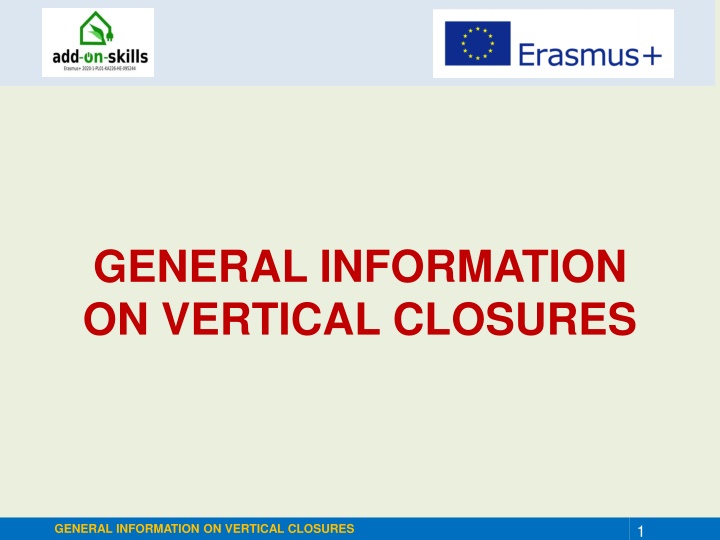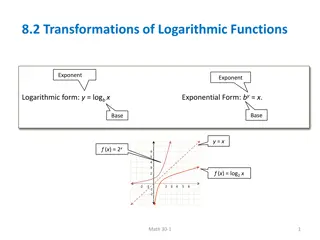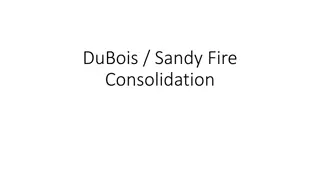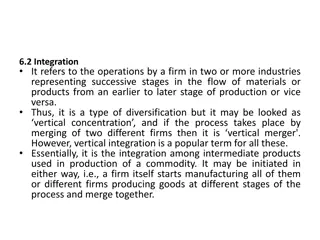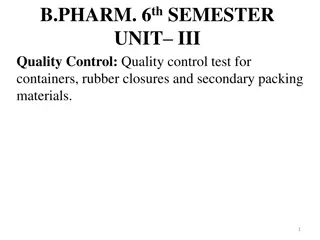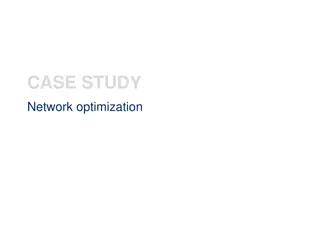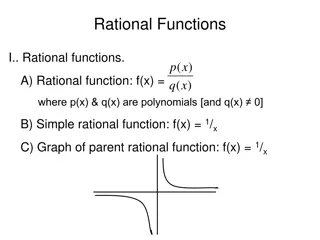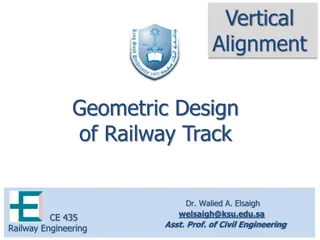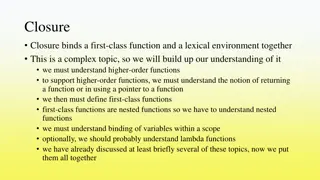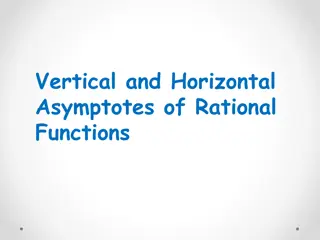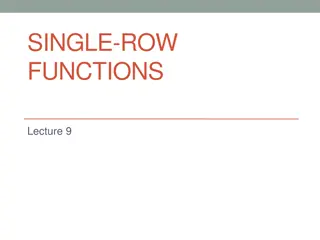Overview of Vertical Closures Functions and Classification
Vertical closures play a crucial role in buildings by acting as filters between indoor and outdoor spaces. They transmit loads, regulate energy flows, lighting, ventilation, and passage. The Italian standards UNI 8369-1 and UNI 7959 provide terminology, classifications, and requirements for external walls. Understanding these elements is essential for designing efficient building systems that meet safety, performance, and regulatory standards.
Download Presentation

Please find below an Image/Link to download the presentation.
The content on the website is provided AS IS for your information and personal use only. It may not be sold, licensed, or shared on other websites without obtaining consent from the author.If you encounter any issues during the download, it is possible that the publisher has removed the file from their server.
You are allowed to download the files provided on this website for personal or commercial use, subject to the condition that they are used lawfully. All files are the property of their respective owners.
The content on the website is provided AS IS for your information and personal use only. It may not be sold, licensed, or shared on other websites without obtaining consent from the author.
E N D
Presentation Transcript
GENERAL INFORMATION ON VERTICAL CLOSURES GENERAL INFORMATION ON VERTICAL CLOSURES 1
Functions of Vertical Closures Vertical closures act as a complex, multifunctional filter between outside and inside the building with the task of: transmit permanent (own weight) and accidental (wind, earthquake and shocks) loads to the load-bearing structure separating and conforming the internal spaces of the building from the outside defending interior spaces from external agents allow and regulate the transmission of energy flows between the interior and exterior of the building system allow and regulate natural lighting and visibility allow and regulate ventilation of interior spaces allow and regulate the passage of people and things between indoor and outdoor spaces GENERAL INFORMATION ON VERTICAL CLOSURES 2
Classification of vertical closures: UNI 8369-1 (Italian standard) UNI 8369-1 (1988) identifies terminology, the classification scheme and the breakdown into further technical elements of vertical closures. It identifies: 1 External wall 2 Vertical external frame 2.1 external window 2.2 screen 3 External locking equipment GENERAL INFORMATION ON VERTICAL CLOSURES 3
Analysis of the requirements of external walls: UNI 7959 The UNI 7959 (1988) (Italian standard) standard provides an analysis of the requirements of the vertical perimeter walls in relation to the conditions of use DEMAND Fundamental need linked to a specific activity Transposition in technical terms of a need. Has a qualitative character REQUIREMENT Behavior of a specific component or building element in its use. Has a quantitative character PERFORMANCE GENERAL INFORMATION ON VERTICAL CLOSURES 4
External walls: requirements and performance Demands of external walls A. Safety B. Hygrometric well-being, thermal resistance and energy savings C. Air purity D. Acoustic insulation E. Appearance F. Feel G. Equipment H. Durability I. Safety during installation J. Maintenance requirements The possibility of measuring or at least evaluating the performance of an external wall in the terms listed above allows for what is called the external specification system. The design of a wall system should aim to achieve the minimum parameters imposed by regulations or common sense. wall performance The design of a wall system should aim to achieve the minimum parameters imposed by regulations or common sense. GENERAL INFORMATION ON VERTICAL CLOSURES 5
External walls: requirements and performance Meeting the requirements is very often linked to the presence of: Internal agents External agents The fa ade components, in their material constitution, are involved in fulfilling certain requirements regardless of the presence of internal/external agents. UNI 7959 provides an exhaustive list of agents that can act on the external wall. This list is an excellent design aid. GENERAL INFORMATION ON VERTICAL CLOSURES 6
External walls: requirements and performance List of internal and external agents 1. Weight (own weight, climatic loads, hanging loads) 2. Wind and static pressure 3. Snow and frost 4. Rain and hail 5. Deformations of structure transmitted to the wall 6. Impacts from outside and inside 7. Explosions 8. Noise from air and ground traffic 9. Soil-transmitted variations 10. Kinetic energy due to the action of earthquakes 11. Solar radiation 12. Ice 13. Lightning 14. Thermal effects due to room heating 15. Acidity of air and rain 16. Saline atmosphere (if present) 17. Dust and Sand 18. Action by animals, bacteria and plant organisms 19. Intrusions atmospheric the load-bearing GENERAL INFORMATION ON VERTICAL CLOSURES 7
External walls: requirements and performance A. Safety requirements Security requirements are understood to be all those triggered by agents that call into question the safety of those occupying the building or present in its surroundings. External walls must be able to effectively resist the occurrence of serious rupture or deformation under the action of mechanical stress. Both functionality over time, but above all the safety of users, must be ensured. A.1. Stability A.2. Wind resistance durability and A.3. Impact resistance A.4. Fire resistance The mechanical resistance of the perimeter walls must be such as to guarantee functionality over time, also in relation to the action of the wind. The size of the load is that provided by national regulations. A.5. Fire reaction durability and A.6. Smoke toxicity containment A.7. Intrusion security building A.8. Safety from electrical or magnetic phenomena GENERAL INFORMATION ON VERTICAL CLOSURES 8
External walls: requirements and performance A. Safety requirements Security requirements are understood to be all those triggered by agents that call into question the safety of those occupying the building or present in its surroundings. The impact resistance of external walls is understood capacity of wall, therefore of its functional layers or constituent components, to stresses arising from impacts that may occur on both the inner and outer faces. A.1. Stability as the A.2. Wind resistance withstand the A.3. Impact resistance A.4. Fire resistance A.5. Fire reaction Fire resistance is defined as the ability of an element to maintain, according to a predefined thermal programme and for a defined time, stability, thermal insulation (REI). A.6. Smoke toxicity containment hermeticity and A.7. Intrusion security A.8. Safety from electrical or magnetic phenomena GENERAL INFORMATION ON VERTICAL CLOSURES 9
External walls: requirements and performance A. Safety requirements Security requirements are understood to be all those triggered by agents that call into question the safety of those occupying the building or present in its surroundings. Reaction to fire is defined as the set of properties of materials, constituting the external walls, seen in relation to the origin and development of a fire. Voluntary standard EN 13501: 2018: class from A to G. A.1. Stability A.2. Wind resistance A.3. Impact resistance A.4. Fire resistance A.5. Fire reaction Containment of smoke toxicity is defined as the ability of perimeter walls to limit the production or effect of material products on system, eyes and skin. (NFX 10702; DIN 50055) A.6. Smoke toxicity containment combustion respiratory the A.7. Intrusion security A.8. Safety from electrical or magnetic phenomena GENERAL INFORMATION ON VERTICAL CLOSURES 10
External walls: requirements and performance A. Safety requirements Security requirements are understood to be all those triggered by agents that call into question the safety of those occupying the building or present in its surroundings. A.1. Stability A.2. Wind resistance A.3. Impact resistance A.4. Fire resistance ability of the perimeter wall to prevent intrusion from the outside by both people and animals. A.5. Fire reaction A.6. Smoke toxicity containment Safety electromagnetic coincides with the ability to limit the effects of these in relation to the part. from electrical phenomena or A.7. Intrusion security A.8. Safety from electrical or magnetic phenomena GENERAL INFORMATION ON VERTICAL CLOSURES 11
External walls: requirements and performance B. Safety requirements These requirements are related to ensuring well-being within a building. These must ensure that precise thermal and relative humidity conditions are maintained Capacity of the external walls, certain functional components constituting prevent excessive heat loss due to the flow of air that may pass through them B.1. Air permeability layers or to it, B.2. Watertightness B.3. Control of interstitial condensation B.4. Thermal insulation Absence of rainwater penetration Behavior of the external wall towards the condensation in the presence of water vapor formation of Capacity of the outer wall to impede the flow of heat GENERAL INFORMATION ON VERTICAL CLOSURES 12
External walls: requirements and performance C. Air purity requirements This requirement relates to the emission of harmful substances or odours, with respect to the olfactory well-being of the environment and the health of the users. Level of odour emission from the outer wall, as a whole and from its individual elements C.1. Emission of odours by materials C.2. No harmful gas, dust or radiation emissions The substances such as gases, dust, fibres, harmful radiation, etc. by the constituent elements of the outer wall under both ordinary and extraordinary conditions is required. non-emission of harmful GENERAL INFORMATION ON VERTICAL CLOSURES 13
External walls: requirements and performance D. Acoustic requirements Requirement related to the protection of interior spaces from noise, both from outside the building and from noise in adjoining rooms. Acoustic external noise insulation against D.1. Insulation from external aero-noise D.2. Lateral or vertical insulation from internal noise Propagation of noise produced in an adjoining room through the external wall D.3. Noise from rain and hail Ability of the wall to keep noise from the impact of rain or hail on the wall from reaching the interior D.4. Acoustic behavior in relation to wind, temperature and humidity variations The external wall must not produce noise due to wind or changes in temperature and humidity GENERAL INFORMATION ON VERTICAL CLOSURES 14
External walls: requirements and performance E. Appearance requirements Requirements concerning the appearance of the external wall. Absence deviations from the theoretical plane to which the wall surface belongs of local or overall E.1. Planarity E.2. Regularity of finishes E.3. Homogeneity of dirtiness Homogeneity homogeneity absence of surface defects of colour, and of gloss The external wall must get evenly dirty GENERAL INFORMATION ON VERTICAL CLOSURES 15
External walls: requirements and performance F. Requirements relating to tactile needs Requirement that the surfaces with which the users of the building may ordinarily come into contact do not present surface characteristics that are disturbing or even dangerous. Requirement relationship user in terms of well-being and safety. involving between the and F.1. Tactile well-being wall GENERAL INFORMATION ON VERTICAL CLOSURES 16
External walls: requirements and performance G. Requirements for carrying loads This refers to the ability of an external wall to withstand both internal and external hanging loads. Ability of an external wall to withstand both external hanging loads G.1. Ability to carry hanging loads internal and GENERAL INFORMATION ON VERTICAL CLOSURES 17
External walls: requirements and performance H. Durability Ability to resist the stresses to which the external wall is subjected, without any loss of performance or the occurrence of any degradation. Withstand the stresses resulting from impacts without degradation of the wall surface, a loss of flatness, water acoustic insulation H.1. Impact resistance H.2. Maintaining performance under the influence of heat, solar radiation, rainwater, frost and defrost tightness or H.3. Resistance to aggressive chemicals, sand and dust Under the effect of heat, sunlight, rainwater, freezing and thawing, there is no loss of performance from the external wall Under the effect of chemicals, sand or dust deterioration of the wall there is no GENERAL INFORMATION ON VERTICAL CLOSURES 18
External walls: requirements and performance I. Production and installation requirements Management of time, space and conditions for storage and wall assembly Weight, expressed in kilograms, of a wall component I.1. Weight I.2. Storage Environmental conditions under which storage can take place I.3. Installation information specialisation of the manpower needed for assembly or the necessary equipment such as the GENERAL INFORMATION ON VERTICAL CLOSURES 19
External walls: requirements and performance I. Production and installation requirements Management of time, space and conditions for storage and wall assembly Direct accessibility to all surfaces, both internal and external, for cleaning J.1. Cleanability J.2. Reparability Replaceability of elements whose breakage or foreseeable deterioration is GENERAL INFORMATION ON VERTICAL CLOSURES 20
External walls: functional layers Breakdown of the external wall into functional layers. A functional layer is a virtual layer that is associated with the satisfaction of a specific requirement. Each functional layer can be matched by one or more physical layers. Functional layers GENERAL INFORMATION ON VERTICAL CLOSURES 21
External walls: functional layers UNI 8979 16 (14+2) Functional layers 8 families 1. 1.1 1.2 1.3 Sealing layers Vapour barrier layer Water seal layer Airtightness layer 6 6.1 6.2 6.3 Resistant layers Protection layer Load-bearing element Load distribution or stiffening layer 2 2.1 2.2 Insulation layers Thermal insulation layer Acoustic insulation layer 7 7.1 7.2 Connecting layers Connecting layer Regularising layer 3 3.1 Ventilation layers Ventilation layer 8 8.1 Fire protection layers Fire protection layer 4 4.1 Vapour diffusion layers Vapour diffusion layer 9 9.1 Thermal storage layers Thermal storage layer 5 5.1 5.2 Cladding layers Outer cladding layer Inner cladding layer GENERAL INFORMATION ON VERTICAL CLOSURES 22
External walls: functional layers Sealing layers Vapour barrier layer 1.1 The vapour barrier layer is adopted in order to prevent condensation from forming in or on the surface of the wall. The position of the vapour barrier layer will be, running the layers from the inside to the outside, the thermal insulation layer first. It is not uncommon to combine the vapour barrier layer with the airtightness layer. GENERAL INFORMATION ON VERTICAL CLOSURES 23
External walls: functional layers Sealing layers Water seal layer 1.2 The watertight layer provides the wall with impermeability from rainwater. This layer must always be present. The location of the layer will be either immediately below the cladding layer or coinciding with it (in any case in an external position). GENERAL INFORMATION ON VERTICAL CLOSURES 24
External walls: functional layers Sealing layers Airtightness layer 1.3 The function of the airtightness layer is precisely to guarantee a predetermined permeability to air and wind pressure. It will be placed below the protective or finishing layer GENERAL INFORMATION ON VERTICAL CLOSURES 25
External walls: functional layers Thermal insulation layer Insulation layers 2.1 It reduces permeability to heat flow through the wall. The best position is on the outside of the wall, but inside in relation to the water seal layer and the ventilation layer. GENERAL INFORMATION ON VERTICAL CLOSURES 26
External walls: functional layers Acoustic insulation layer Insulation layers 2.2 The acoustic insulation layer ensures the soundproofing power of the wall. A good design strategy is to make the wall function as an elastic damper, thus a layering that follows the mass-spring-mass pattern. The acoustic insulation layer does not need to be precisely positioned in the stratigraphy of the wall. GENERAL INFORMATION ON VERTICAL CLOSURES 27
External walls: functional layers 3.1 Ventilation layers Ventilation layer The purpose of the ventilation layer is to control the thermo-hygrometric behaviour of the wall by means of ventilation, natural or mechanical, within the wall. This layer will be positioned between the external cladding layer and the thermal insulation layer. GENERAL INFORMATION ON VERTICAL CLOSURES 28
External walls: functional layers Vapour diffusion layers Vapour diffusion layer 4.1 Its function is to prevent abnormal pressures from building up inside the wall. It generally consists of an air space positioned on the hot face of the vapour barrier. It can coincide with the ventilation layer, the connecting layer or the regularizing layer. GENERAL INFORMATION ON VERTICAL CLOSURES 29
External walls: functional layers Cladding layers 5.1 Outer cladding layer The outer cladding layer fulfils the dual function of protecting the inner layers from atmospheric agents and aesthetically qualifying the fa ade. Its position is the outermost in relation to the other layers. Very often it also fulfils the function of a water and airtight layer. GENERAL INFORMATION ON VERTICAL CLOSURES 30
External walls: functional layers Cladding layers 5.2 Inner cladding layer It fulfils the role of the wall's interface with the internal space. Its characteristics will be related to the requirements of appearance, impact resistance and protection of the innermost layers from possible degradation agents produced by the activities carried out inside the rooms. It is the layer most towards the interior of the wall. GENERAL INFORMATION ON VERTICAL CLOSURES 31
External walls: functional layers Resistant layers Protection layer 6.1 It has the function of collecting the stresses given by the weight of the layers connected to it, those given by the wind and then transmitting them to the resistant load-bearing layer. The position is the outermost and innermost between the layers of the wall, with the outermost ones remaining the cladding layers. Resistant layers Load-bearing element 6.2 This layer has the function of providing the mechanical resistance of the wall, so it will have to withstand the stresses caused by its own weight, wind and impacts on the outside and inside of the wall. GENERAL INFORMATION ON VERTICAL CLOSURES 32
External walls: functional layers Resistant layers Load distribution or stiffening layer 6.3 This layer has the function of bearing and therefore distributing concentrated loads. The location of this layer will be below the finishing layers, both internal and external. It will also have to guarantee the protection of the thermal insulation element. GENERAL INFORMATION ON VERTICAL CLOSURES 33
External walls: functional layers Connecting layers Connecting layer 7.1 This layer has the fundamental function of ensuring the attachment of all layers to the load-bearing element. The location of this layer is always constrained by the possibility of connecting the various layers to the load-bearing element. Connecting layers Regularising layer 7.2 It has the function of reducing the surface irregularities of one layer when a second layer is superimposed. This layer is usually present above those that will accommodate the vapour barrier, and below the water and air sealing element. GENERAL INFORMATION ON VERTICAL CLOSURES 34
External walls: functional layers Fire protection layers Fire protection layer 8.1 Its function is to guarantee the required overall fire resistance of the closure. GENERAL INFORMATION ON VERTICAL CLOSURES 35
External walls: functional layers Thermal storage layers Thermal storage layer 9.1 This is the layer whose function is to bring the global thermal inertia characteristics of the closure to the required value. This element generally consists of a massive layer placed in direct thermal contact with the internal environment. GENERAL INFORMATION ON VERTICAL CLOSURES 36
THANK YOU FOR YOUR ATTENTION Professor: PhD Eng. Vincenzo Di Naso vincenzo.dinaso@unifi.it Department of Civil and Environmental Engineering of Florence GENERAL INFORMATION ON VERTICAL CLOSURES 37
External walls: functional layers Demand: Fundamental need linked to a specific activity. G L O S S A R Y Requirement: Transposition in technical terms of a need. Has a qualitative character. Performance: Behavior of a specific component or building element in its use. Has a quantitative character. Functional layers: virtual layer that is associated with the satisfaction of a specific requirement. Each functional layer can be matched by one or more physical layers. GENERAL INFORMATION ON VERTICAL CLOSURES 38
External walls: functional layers Place the following functional layers in the correct order from the inside to the outside: Vapour barrier layer Thermal storage layer T E S T Outer cladding layer Inner cladding layer Thermal insulation layer Ventilation layer GENERAL INFORMATION ON VERTICAL CLOSURES 39
This project has been funded with support from European Commission. This publication [communication] reflects the views only of the author, and the Commission cannot be held responsible for any use which may be made of the information contained therein.
